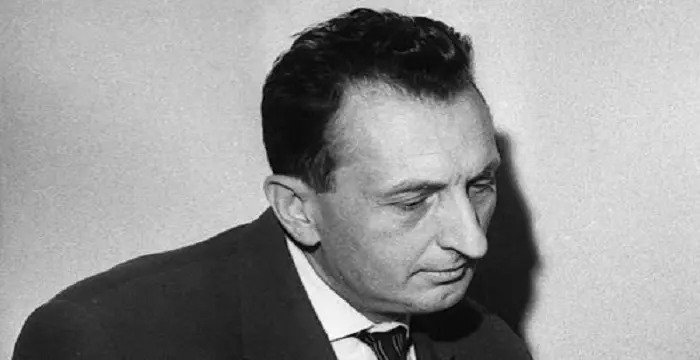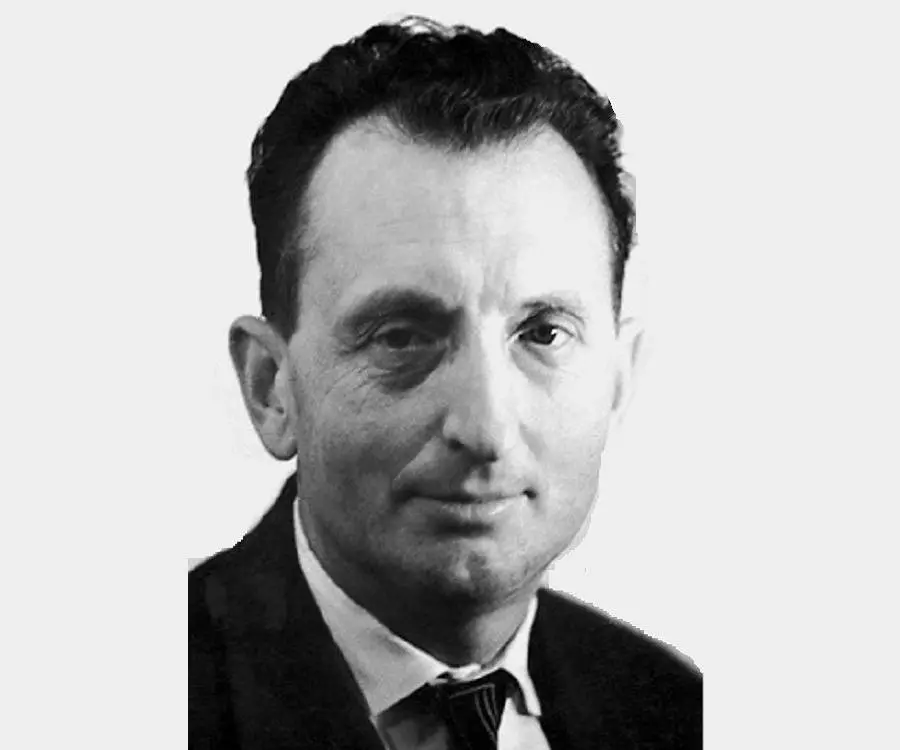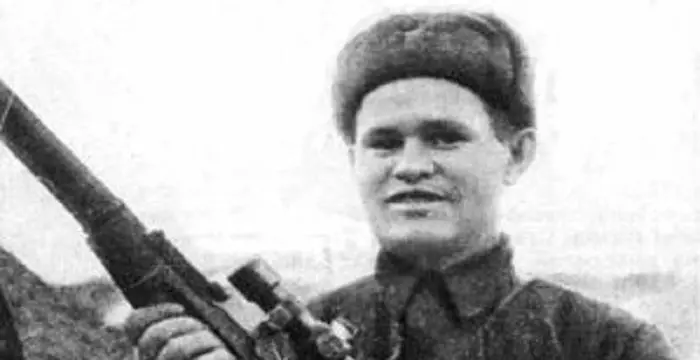
Aleksandr Prokhorov - Scientists, Birthday and Facts
Aleksandr Prokhorov's Personal Details
Aleksandr Prokhorov was a Soviet physicist who earned the Nobel Prize for his pioneering work on laser-maser principle
| Information | Detail |
|---|---|
| Birthday | July 11, 1916 |
| Died on | January 8, 2002 |
| Nationality | Russian |
| Famous | Scientists, Physicists |
| Spouses | Galina Shelepina |
| Known as | Alexander Mikhaylovich Prokhorov |
| Childrens | Kiril |
| Birth Place | Atherton, Queensland, Australia |
| Gender | Male |
| Sun Sign | Cancer |
| Born in | Atherton, Queensland, Australia |
| Famous as | Physicist |
| Died at Age | 85 |
// Famous Physicists
Henry Cavendish
Henry Cavendish was a theoretical chemist and physicist, renowned for discovery of hydrogen and calculation of the mass of earth. To know more about his childhood, profile, timeline and career read on
Walter Kohn
Nobel Laureate Walter Kohn was an Austrian-born American theoretical chemist and physicist. Check out this biography to know about his childhood, life, achievements, works & timeline.
Nikola Tesla
Nikola Tesla was a Serbian-American inventor, best known for his development of alternating current electrical systems. This biography of Nikola Tesla provides detailed information about his childhood, life, achievements, works & timeline.
Aleksandr Prokhorov's photo
Who is Aleksandr Prokhorov?
Aleksandr Prokhorov was one of the frontrunners of Russian physics who earned a Nobel Prize in 1964 for developing the maser-laser principle. He shared the prize with Nikolay Basov and Charles Townes. Prokhorov studied at the Leningrad State University and later worked at the Lebedev Physical Institute. It was during the early 1950s that Prokhorov carried out his pioneering work on the maser-laser principle together with Nikolay Basov. He remained active in laser research and development for the rest of his life, working on solid-state lasers, fibre optics, and laser applications in medicine and environmental monitoring. Apart from his scientific research work, Prokhorov took up academic duties in various Soviet establishments. He served as a Professor of the Moscow State University. He was an acting director of the General Physics Institute of the Russian Academy of Sciences and later became an honorary director. He was also a member and one of the Honorary Presidents of the International Academy of Science, Munich.
// Famous Scientists
Juliane Koepcke
Juliane Koepcke is a German-Peruvian biologist, who was the lone survivor among the 92 passengers and crew of the ill-fated LANSA Flight 508 that crashed in the Peruvian rainforest on 24 December 1971. Know more about her life in this biography.
Henry Cavendish
Henry Cavendish was a theoretical chemist and physicist, renowned for discovery of hydrogen and calculation of the mass of earth. To know more about his childhood, profile, timeline and career read on
Konstantin Tsiolkovsky
Konstantin Tsiolkovsky was a Russian rocket scientist and a pioneer of astronautics. This biography provides detailed information about his childhood, family, personal life, career, achievements, etc.
Childhood & Early Life
Aleksandr Prokhorov was born on July 11, 1916 in Atherton, Queensland, Australia to revolutionary Russian parents who had emigrated from Russia and were serving a period of exile in Australia.
Following the Great October Revolution, Prokhorov and his family shifted back to Russia where they originally belonged. In Russia, Prokhorov enrolled at the Leningrad State University to study physics. He graduated with honors from the same in 1939.
Career
Following his graduation, Aleksandr Prokhorov moved to Moscow where he started work in the oscillation laboratory at the Lebedev Physical Institute, under academician ND Papaleksi. At Lebedev Institute, Prokhorov studied the propagation of radio waves in ionosphere.
During the early 1940s, with the onset of World War II, he enrolled himself in the Red Army. He fought in the infantry. Three medals and two major wounds later, he returned to the oscillation laboratory at the Lebedev Institute in 1944 to continue with his study and research. He investigated nonlinear oscillations under Professor SM Rytov.
In 1946, he defended his PhD thesis on ‘Theory of Stabilization of Frequency of a Tube Oscillator in the Theory of a Small Parameter’. The following year, he started working on coherent radiation emitted by electrons orbiting in a cyclic particle accelerator called synchrotron. He demonstrated that the emission is mostly concentrated in the microwave spectral range.
His study of the coherent radiation of electrons in the synchrotron in the region of centimetre waves formed the basis of his 1951 PhD thesis ‘Coherent Radiation of Electrons in Synchotron Accelerator’. Meanwhile, by 1950, Prokhorov was made assistant chief of the oscillation laboratory. Nikolay Basov was one of his students.
As an assistant chief, he formed a group of students and started working on radiospectroscopy of molecular rotations and vibrations. He later concentrated his study on quantum electronics. The group based much of their theoretical and practical study on a special class of molecules which had three non-degenerated moments of inertia.
The development of radar during wartime had made microwave equipment readily available. Much like his American and British counterparts who had started using the microwave equipment to study how atoms and molecules responded to microwave frequencies, Prokhorov too studied the same. Along with Basov, he began experimenting with beams of molecules which were all moving at a uniform velocity.
By 1954, he became the head of the laboratory. Subsequently, he, along with Basov, found that they could isolate molecules that were in an excited state in a separate beam. This gave them their biggest breakthrough. When extra energy from excited molecules was released in the form of a microwave, unexcited molecules absorbed the wave. However, if most molecules were excited, the microwave would stimulate other molecules to emit their energy at the same wavelength
Prokhorov and Basov also found that when molecular beam passed through a suitable microwave resonator, the emission built up on its own, or oscillated, generating microwaves that were aligned in phase and at the same wavelength. Analysing the process in detail, they published their findings in 1954.
The research work carried out by Prokhorov and Basov in the field of microwave spectroscopy resulted in the idea of a molecular oscillator. They developed theoretical grounds for creation of a molecular oscillator and also constructed a molecular oscillator operating on ammonia. In 1955, the duo came up with a method for the production of a negative absorption which was called the pumping method.
In 1955, he commenced his research in the field of electron paramagnetic resonance (EPR). He carried out a cycle of investigations of EPR spectra and relaxation time in various crystals, primarily focussing on investigations on ions of the iron group elements in the lattice of aluminium oxide. He also investigated other, ‘non-optical’ topics, such as magnetic phase transitions in DPPH
While researching in the field of EPR, he collaterally studied the EPR spectra of ruby with A.A Manenkov. In 1957, he was struck with the idea of using ruby as a material for laser. He designed and constructed this new type of laser resonator called maser, using various materials. Most of his research on masers was done in cooperation with the laboratory of radiospectroscopy at the Institute of Nuclear Physics at Moscow University
In 1958, he suggested a laser for generation of far-infrared waves. As a resonator it was proposed to use a new type of cavity which was eventually named ‘the cavity of an open type’. Similar cavities are widely used in lasers.
In 1959, he was appointed as the professor at the Moscow State University, the most prestigious university in Soviet Union.
In 1968, he took up the position of Vice Director at the Lebedev Institute and later in 1971, the position of Head of the Laboratory at the Moscow Institute of Physics and Technology.
From 1982 to 1998, he served as the Acting Director of the General Physics Institute of the Russian Academy of Sciences. From 1988, he was promoted as an Honorary Director.
During his lifetime Prokhorov was a member and one of the Honorary Presidents of the International Academy of Science, Munich. In 1993, he supported the foundation and development of the Russian Section of International Academy of Science, Moscow.
Major Works
The heart of Prokhorov’s research work came during the early 1950s when he along with his collaborators investigated molecular structures by the methods of microwave spectroscopy. Together with Basov, he began experimenting with beam of molecules that were moving at a uniform velocity with an aim to improve the resolution of their microwave measurements. The duo found out that they could isolate molecules that were in an excited state in a separate beam, leading to a breakthrough.
They also discovered that if the molecular beam passed through a suitable microwave resonator, the emission would build up on its own, or oscillate, ultimately generating microwaves aligned in phase and at the same wavelength. Their pioneering work on lasers and maser eventually earned them a Nobel Prize in Physics in 1964.
Awards & Achievements
In 1959, Prokhorov was awarded the Lenin Prize.
In 1960, he was appointed as a member of the Russian Academy of Sciences. Six years later in 1966, he was elected as an academician.
In 1964, Prokhorov was awarded Nobel Prize in Physics, which He shared with Nikolay Basov and Charles Townes. The trio received the award for their fundamental work in the field of quantum electronics which led to the construction of oscillators and amplifiers based on maser-laser principle.
He became a Hero of Socialist Labour, the highest degree of distinction in the Soviet Union for achievements in national economy and culture, twice in 1969 and 1986.
In 1971, he was elected a member of the American Academy of Arts and Sciences.
In 2000, he received the Frederic Ives Medal, the highest distinction of the Optical Society of America (OSA). Following year, he became an honorary OSA member. Simultaneously, he also received the Demidov Prize.
Personal Life & Legacy
In 1941, Prokhorov married geographer Galina Shelepina. The couple as blessed with a son, Kiril, in 1945. Kiril followed the footstapes of his father and has become a physicist in the field of optics. Currently, he leads a laser-related laboratory at the A. M. Prokhorov General Physics Institute.
Prokhorov breathed his last on January 8, 2002 in Moscow, Russia.
The Russian Academy of Sciences, where Prokhorov served as an honorary director, was reamed A. M. Prokhorov General Physics Institute of the Russian Academy of Sciences, following his death.
// Famous Cancer Celebrities peoples
Jacob Elordi
Jacob Elordi is an Australian actor. Let’s take a look at his childhood, family, personal life, career, etc.
Riele Downs
Riele Downs is a Canadian-American actress & Musical.ly star. Let’s take a look at her family and personal life including age, birthday, net worth, boyfriends and fun facts.
Yammy Xox
Check out all that you wanted to know about Yammy Xox, the famous British YouTube Personality; her birthday, her family and personal life, her boyfriends, fun trivia facts and more.
Aleksandr Prokhorov's awards
| Year | Name | Award |
|---|---|---|
Other | ||
| 0 | 1964 Nobel Prize in Physics | |
| 0 | 1987 Lomonosov Gold Medal | |
Aleksandr Prokhorov biography timelines
- // 11th Jul 1916Aleksandr Prokhorov was born on July 11, 1916 in Atherton, Queensland, Australia to revolutionary Russian parents who had emigrated from Russia and were serving a period of exile in Australia.
- // 1939Following the Great October Revolution, Prokhorov and his family shifted back to Russia where they originally belonged. In Russia, Prokhorov enrolled at the Leningrad State University to study physics. He graduated with honors from the same in 1939.
- // 1941In 1941, Prokhorov married geographer Galina Shelepina. The couple as blessed with a son, Kiril, in 1945. Kiril followed the footstapes of his father and has become a physicist in the field of optics. Currently, he leads a laser-related laboratory at the A. M. Prokhorov General Physics Institute.
- // 1944During the early 1940s, with the onset of World War II, he enrolled himself in the Red Army. He fought in the infantry. Three medals and two major wounds later, he returned to the oscillation laboratory at the Lebedev Institute in 1944 to continue with his study and research. He investigated nonlinear oscillations under Professor SM Rytov.
- // 1946In 1946, he defended his PhD thesis on ‘Theory of Stabilization of Frequency of a Tube Oscillator in the Theory of a Small Parameter’. The following year, he started working on coherent radiation emitted by electrons orbiting in a cyclic particle accelerator called synchrotron. He demonstrated that the emission is mostly concentrated in the microwave spectral range.
- // 1950 To 1951His study of the coherent radiation of electrons in the synchrotron in the region of centimetre waves formed the basis of his 1951 PhD thesis ‘Coherent Radiation of Electrons in Synchotron Accelerator’. Meanwhile, by 1950, Prokhorov was made assistant chief of the oscillation laboratory. Nikolay Basov was one of his students.
- // 1954By 1954, he became the head of the laboratory. Subsequently, he, along with Basov, found that they could isolate molecules that were in an excited state in a separate beam. This gave them their biggest breakthrough. When extra energy from excited molecules was released in the form of a microwave, unexcited molecules absorbed the wave. However, if most molecules were excited, the microwave would stimulate other molecules to emit their energy at the same wavelength
- // 1954Prokhorov and Basov also found that when molecular beam passed through a suitable microwave resonator, the emission built up on its own, or oscillated, generating microwaves that were aligned in phase and at the same wavelength. Analysing the process in detail, they published their findings in 1954.
- // 1955The research work carried out by Prokhorov and Basov in the field of microwave spectroscopy resulted in the idea of a molecular oscillator. They developed theoretical grounds for creation of a molecular oscillator and also constructed a molecular oscillator operating on ammonia. In 1955, the duo came up with a method for the production of a negative absorption which was called the pumping method.
- // 1955In 1955, he commenced his research in the field of electron paramagnetic resonance (EPR). He carried out a cycle of investigations of EPR spectra and relaxation time in various crystals, primarily focussing on investigations on ions of the iron group elements in the lattice of aluminium oxide. He also investigated other, ‘non-optical’ topics, such as magnetic phase transitions in DPPH
- // 1957While researching in the field of EPR, he collaterally studied the EPR spectra of ruby with A.A Manenkov. In 1957, he was struck with the idea of using ruby as a material for laser. He designed and constructed this new type of laser resonator called maser, using various materials. Most of his research on masers was done in cooperation with the laboratory of radiospectroscopy at the Institute of Nuclear Physics at Moscow University
- // 1958In 1958, he suggested a laser for generation of far-infrared waves. As a resonator it was proposed to use a new type of cavity which was eventually named ‘the cavity of an open type’. Similar cavities are widely used in lasers.
- // 1959In 1959, Prokhorov was awarded the Lenin Prize.
- // 1960 To 1966In 1960, he was appointed as a member of the Russian Academy of Sciences. Six years later in 1966, he was elected as an academician.
- // 1964They also discovered that if the molecular beam passed through a suitable microwave resonator, the emission would build up on its own, or oscillate, ultimately generating microwaves aligned in phase and at the same wavelength. Their pioneering work on lasers and maser eventually earned them a Nobel Prize in Physics in 1964.
- // 1964In 1964, Prokhorov was awarded Nobel Prize in Physics, which He shared with Nikolay Basov and Charles Townes. The trio received the award for their fundamental work in the field of quantum electronics which led to the construction of oscillators and amplifiers based on maser-laser principle.
- // 1969 To 1986He became a Hero of Socialist Labour, the highest degree of distinction in the Soviet Union for achievements in national economy and culture, twice in 1969 and 1986.
- // 1971In 1971, he was elected a member of the American Academy of Arts and Sciences.
- // 1993During his lifetime Prokhorov was a member and one of the Honorary Presidents of the International Academy of Science, Munich. In 1993, he supported the foundation and development of the Russian Section of International Academy of Science, Moscow.
- // 2000In 2000, he received the Frederic Ives Medal, the highest distinction of the Optical Society of America (OSA). Following year, he became an honorary OSA member. Simultaneously, he also received the Demidov Prize.
- // 8th Jan 2002Prokhorov breathed his last on January 8, 2002 in Moscow, Russia.
// Famous Russian peoples
Vasily Zaytsev
Vasily Zatysev was a Russian sniper who served during the World War II. Check out this biography to know about his childhood, family life, achievements and fun facts about him.
Zyzz (Aziz Shavershian)
Zyzz (Aziz Shavershian) was a popular Australian Body Builder and internet personality. Check out this biography to know about his childhood, family life, achievements and other facts about his life.
Kristina Pimenova
Read this bio to gather several facts, trivia and many details related to the personal and family life of Kristina Pimenova.
Nikolai Valuev
Nikolai Valuev is a Russian retired professional boxer, actor, politician, and author. Check out this biography to know about his childhood, family life, achievements and fun facts about him.
Olesya Rulin
Olesya Rulin is a Russian-American actress, best known for her role in Disney's commercially successful ‘High School Musical’ franchise. Check out this biography to know about her childhood, family life, achievements and fun facts about her life.
Vitaly Zdorovetskiy
Check out all that you wanted to know about Vitaly Zdorovetskiy, the budding YouTube Personality; his birthday, family and personal life, his girlfriends, fun trivia facts and more.
Aleksandr Prokhorov's FAQ
What is Aleksandr Prokhorov birthday?
Aleksandr Prokhorov was born at 1916-07-11
When was Aleksandr Prokhorov died?
Aleksandr Prokhorov was died at 2002-01-08
Where was Aleksandr Prokhorov died?
Aleksandr Prokhorov was died in Moscow, Russia
Which age was Aleksandr Prokhorov died?
Aleksandr Prokhorov was died at age 85
Where is Aleksandr Prokhorov's birth place?
Aleksandr Prokhorov was born in Atherton, Queensland, Australia
What is Aleksandr Prokhorov nationalities?
Aleksandr Prokhorov's nationalities is Russian
Who is Aleksandr Prokhorov spouses?
Aleksandr Prokhorov's spouses is Galina Shelepina
Who is Aleksandr Prokhorov childrens?
Aleksandr Prokhorov's childrens is Kiril
What is Aleksandr Prokhorov's sun sign?
Aleksandr Prokhorov is Cancer
How famous is Aleksandr Prokhorov?
Aleksandr Prokhorov is famouse as Physicist














